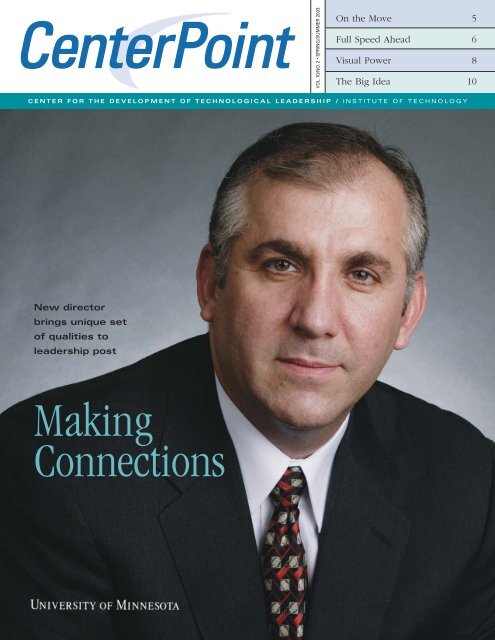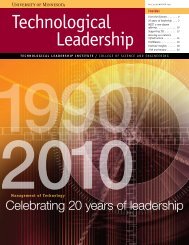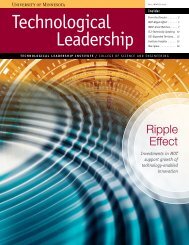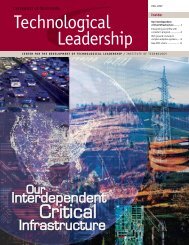Spring/Summer 2003 - Technological Leadership Institute
Spring/Summer 2003 - Technological Leadership Institute
Spring/Summer 2003 - Technological Leadership Institute
- No tags were found...
You also want an ePaper? Increase the reach of your titles
YUMPU automatically turns print PDFs into web optimized ePapers that Google loves.
New director brings unique setof qualities to leadership postMakingConnections
“Our connections to high-tech companies allow us tounderstand the needs of the high-technology communityand address those needs by tailoring solutionsthat are also built around our strengths.”BUILDING ON A STRONG FOUNDATIONWhen Massoud Amin became the new director of the Center for the Development of<strong>Technological</strong> <strong>Leadership</strong> (CDTL) in March, he assumed leadership not only for threeprofessional degree programs, but also for short courses and other educationalpackages that benefit the state’s high-technology community.Where will CDTL go from here?The answer to that question, in part, will come from the development of a three-yearroadmap, says Amin, who plans to involve industry representatives in developing thestrategic plan.Whatever directions may emerge from the strategic plan, CDTL remains committedto the technology community that it serves and to the principles behind its professionalprograms, he says. That commitment includes the following components:Continuing to excel in delivering the center’s flagship management of technology (MOT)degree program. The MOT degree offers the high-technology community a way to investin its managers and leaders. The program’s unique value to the community grows eachyear as more graduates complete the program and as CDTL increases its collaborationswith industry.Offering other professional degree programs for technical professionals and leaders thatfill a market need and fit well with the CDTL model for professional degree programdelivery. Both current programs, software engineering and infrastructure systems engineering,resulted from needs that the local community helped identify. As appropriate,CDTL will explore other possibilities for degree programs.Refining the elements that make the management of technology field unique. As thecomplexity of issues that surround technology development grows, new dimensions ofmanagement of technology issues emerge. Whether technology forecasting or systemanalysis, CDTL plans to remain a leader in understanding the management of technologyand its implications for the high-technology community it serves.Identifying educational products that share those developments with the high-technologycommunity. Collaborations with industry will help CDTL determine the most effectiveways to present and deliver educational offerings on new topics, whether short courses,forums, or other methods.Adding a research component into the mix. By becoming a home to faculty from variousdisciplines, CDTL intends to help facilitate research in the management of technologyand technology systems areas that cuts across disciplines. CDTL also is in a uniqueposition to bring the results and application of that research into the classroom, sharingwith professionals the latest in thought and practice.Amin takes a broad view of technologyand the management of technology—aview that complements thework of CDTL in defining the uniqueaspects of technology management.Technology, he says, has playedand will continue to play a key role inraising the quality of life for individualsand society as a whole. As technologiesexpand capabilities, understanding theworkings of the whole system takes onan even greater relevance, he says.“Innovation and intelligent managementof technology is needed evenmore now than ever before,” he says.“The ability to deal with the wholesystem and the people in that systembecomes crucial to effective managementof technology.”His current work embraces an evenbroader perspective, the concept ofglobal transition dynamics, which callsfor an integrated planning approach toguide national and global technologydevelopment.With roots firmly grounded inresearch that spans many disciplines,Amin looks forward to working withcolleagues in the <strong>Institute</strong> of Technology(IT) and in industry on researchcollaborations that advance the managementof technology in a diversity offields and industries. In addition toserving as the center’s director and asthe H.W. Sweatt Chair, he holds a facultyappointment within IT’s electricaland computer engineering department.“There are many challenges in infrastructures,manufacturing, and softwarethat will persist, requiring solutionsusing hard engineering,” says Amin.“These challenges will provide the idealopportunity for experience and growthwithin CDTL, IT, and beyond.”In the spring and summer, Amin willmeet with faculty, students, and industryrepresentatives and begin planning4 CenterPoint
FULL SPEEDAHEADWhat happens to alumni after they receivetheir master of science degree in themanagement of technology (MOT)? Dothey assume greater management responsibilities?Do they make more money? Arethey more valuable to their companies?Surveyreveals thatMOT alumnicontinue toadvanceBased on the results of a survey of MOTalumni, the answers to those questions are aresounding “yes.”The Center for the Development of <strong>Technological</strong><strong>Leadership</strong> (CDTL), which administers theprogram, conducted a survey in 2002 withresponses from 65 percent of the alumni inthe classes of 1992 to 1999. CDTL previouslysurveyed alumni in 1997.“We began surveying alumni to learn moreabout what they thought of the program and howit helped them,” says Rose Jones, CDTL associatedirector. “The information helps us measure theeffectiveness of the program and plan forimprovements and new directions.”Higher and happierSo what does happen to alumni after theygraduate? According to the survey, many alumnifind themselves making advances in their careersand in their salaries:• At the start of the program, 32 percent enteredthe program as managers. In contrast, 44percent currently hold management positions.In addition, 15 percent reached the executivelevel, compared to only a few who entered theprogram as vice presidents or chief executiveofficers.• Compared to only 8 percent of alumni at thestart of the program, 79 percent of currentalumni earn $90,000 or more. The majorityremained at or above the median salaryfor individuals in engineering managementpositions statewide (Minnesota WorkforceCenter System, Quarter 4, 2002, Report).More alumni now than in the 1997 study alsoreported working in positions related to themanagement of technology and finding satisfactionwith their positions.• In the 1997 survey, 64 percent were employedin positions that related either highly or veryhighly to the MOT program, compared with 75percent in the most recent survey.• Job satisfaction increased from 76 percent in1997 to 80 percent in 2002.An interesting transformation seems to happenduring and after the time that alumni spend inthe program.While 54 percent of alumni reported beingsatisfied or very satisfied with their jobs at thestart of the program, 80 percent of alumnireported satisfaction with their current job—ajump of 26 percent.“It’s not surprising to me that satisfactionincreases,” says Jones. “For many alumni, theMOT program opens new doors—whether thatresults in a new position, assignment to interestingand more complex projects, or additionalresponsibilities.”Same organization, new roleMany organizations send candidates to theMOT program as a way to further develop theleadership abilities of high-potential employees.In turn, the vast majority of MOT alumni—69 percent—staywith the organization that supportedthem during their MOT program, often receivingpromotions and salary increases. On average, thealumni reported making 2.6 job changes sinceleaving MOT, with the majority citing a chancefor increased responsibility as the reason.“Organizations recognize the value that theknowledge gained in an MOT program brings,”says Jones. “MOT alumni leave the programready for new challenges, and organizations wantthem to make use of that knowledge. It’s a winwinsituation.”On-the-job relevanceMOT impacted several key areas of their currentjobs in an important or very important way,according to alumni who completed the survey.Those areas include:• Strategic management (83 percent said MOTwas important or very important in preparingfor this area of their current job)6 CenterPoint
• <strong>Leadership</strong> (79 percent)• Critical thinking (77 percent)• General management (76 percent)• Collaboration (71 percent)In general, 82 percent reported that MOTwas important or very important in developingskills for their current job, and 91 percentsaid that the program was important or veryimportant in developing skills for their careerpath.Who respondedIn 2002, CDTL surveyed 224 management of technology (MOT) alumnifrom the classes of 1992 to 1999, with 147 responding. Survey resultsreveal the following information about those MOT alumni.AGE31 – 35 • 8%36 – 45 • 59%Strengths and opportunitiesOverall, MOT alumni rate the programhighly, with 90 percent saying they weresatisfied with the program and 89 percentsaying that they would recommend it toothers.“I thought the greatest strength was theway the typical business concepts andinstruction was focused on technology companies,”wrote one alumnus. “The emphasison technology made the program significantlymore relevant than a standard MBAprogram.”Alumni identified the following attributesas the program’s strongest points:• Class discussions, quality of the students,study groups, student cohorts, connectionsto classmates after graduation• Excellent quality of faculty, diversity offaculty, connection of faculty to theCarlson School of Management• Breadth of program, breadth of coursework, connection of course work totechnology, leadership, and businessThey also cited several areas that they feltcould improve:• Awareness of the program or itssignificance in some segments of thebusiness technology sector• Time commitment; the capstonerequirementNext stepsCDTL will continue to analyze informationfrom the study as it looks for ways toimprove the MOT program.“The study tells us that we are deliveringwhat professionals need to take them to thenext level,” says Jones. “We are fortunate tohave alumni who are willing to share theirideas and to stay connected with us. Withtheir help, we can continue to makeimprovements.”Look for a summary report on CDTL’sweb site at www.cdtl.umn.edu. Click on“2002 MOT Follow-Up Study.”UNDERGRADUATE MAJORSINDUSTRYCORE BUSINESSESCOMPANY SIZE (employees)46 – 55 • 31%55+ • 2%Electrical Engineering • 26%Mechanical Engineering • 22%Chemical Engineering • 15%Chemistry/Physics • 10%Other • 27%Manufacturing • 65%Government • 6%Software Development • 5%Consulting • 5%Education • 4%Other • 16%Computer/Electronic Equipment • 18%Defense Systems • 11%Industrial Machinery/Equipment • 8%Chemical/Allied Products • 7%Surgical/Medical Instruments • 7%Information Systems • 4%Healthcare Services • 4%Instruments/Related Products • 3%Other • 32%0 – 49 • 10%50 – 100 • 2%100 – 249 • 1%250 – 499 • 9%500 – 2500 • 10%2500+ • 68%<strong>Spring</strong>/<strong>Summer</strong> <strong>2003</strong> 7
Brad Henry, who teaches the GIS class for the infrastructure systems engineering program, wants students to understand the value of GIS.addition, GIS maps and simulationsmake the presentation of the designplan to local government and communitymembers clearer and moreunderstandable.Because they can combine dataabout existing systems with the physicalfeatures of the land, maps also assistengineers in maintaining the infrastructure.The maps that engineers createare also valuable GIS tools for theentire organization. For example, inRoseville, GIS is even helping improvepublic safety. Windle shared with theclass GIS maps that showed the impactof potential emergencies on the city’sinfrastructure and identified those communitymembers who might be affectedduring such emergencies, such as aleak in an oil tank or a tornado.Guest speakers, such as Windle,help students learn more about thepractical application of GIS from severaldifferent viewpoints, says Henry. InHenry’s class, students experience ahands-on approach to learning. “I wantstudents to get excited about the possibilitiesand give them the tools thatthey need to apply this when they goback to work,” he says.As part of one class assignment, theylocated an address from three differentdatabases and found inconsistencies.Henry’s point: Databases that organizationsbuild aren’t always correct. Engineerscan use GIS as a tool to see andcorrect database errors, increasing thetrust in decisions that result from thosedatabases.Students also analyze the costs andbenefits of generating a GIS projectfrom scratch. The cost to generate GIScan be high, but Henry wants them tounderstand some important concepts.First, it is possible for engineeringdepartments to justify the cost ofcomprehensive mapping databases bycreating them efficiently, just for theengineering planning and designprocess. Second, the class learns abouta wide variety of benefits of GIS inengineering, including eliminatingmapping redundancy. And third, collaboratingwith local and regional governmentslowers GIS costs by spreadingthem among many users.To gain an understanding of how tocombine raw data and turn it intomeaningful GIS products, studentscreate GIS maps manually and latercompose maps in a GIS computerlaboratory. Students also write a finalpaper on ways that they might use GISwithin their organization.“GIS is a tool that engineers can useto better serve the public,” says Henry.“If they use this tool to better managethe infrastructure, it will lead to tangiblebenefits for the entire community.”<strong>Spring</strong>/<strong>Summer</strong> <strong>2003</strong> 9
Students in the master of science programs administered by the Center for the Development of<strong>Technological</strong> <strong>Leadership</strong> complete a final capstone project, which often focuses on an issue ofimportance to them and their organization. Last spring, Centerpoint included a story on capstoneprojects. This follow-up story features capstone projects from the software engineering program.The BigIdeaExpanding the playing fieldPeter Pascale left inspired and ready for action after hearinga talk by Maria Gini, computer science and engineeringprofessor, about artificial intelligence. He began thinkingabout ways to make the communication among computercontrolledcharacters more human, and, in the end, he turnedhis capstone project into a game—literally.Applications, such as bartering, e-commerce, and robotsearch and rescue, all rely on agents—the players—toPeter Pascale, software developer at NCS Pearson, turned his capstoneproject into a game—literally.10 CenterPoint
interact. While applications allow for solo—autonomous—agents to play games, less work has been done in refiningthe ability of agents to work effectively as part of teams. Inhis project, Pascale used multi-agent concepts and research toimprove coordination among autonomous agents in a teambasedaction game for the personal computer.Pascale, a software developer at NCS Pearson, focused onthe development of a communication framework for agentsin the gaming environment. His project involved the followingtasks:• researching current techniques, frameworks, and environments• gaining an understanding of the fundamental elements ofmulti-agent communication• reverse engineering an existing gaming framework todiscover the features that favor communication amonggame players, including human-to-agent and agent-to-agentcommunication• establishing a communication design to support multi-agentcommunication, including message specification and amessage send-and-receive framework• developing a prototype of the communication designAs part of the project, he produced a small working demobased on some key design elements. “I created the ability forthe agents to have dynamic leadership and a simple systemfor sending communications,” he says. When the leader dies,the nearest team member becomes the team leader, andmembers can dynamically interpret who became the teamleader.In the end, the capstone was hard work and fun. It alsowas a valuable educational experience. “I learned the valueof playing with the technology and prototyping early,” saysPascale. “I learned a lot about the state of multi-agentresearch and just how difficult the problems are that itpresents.”While relatively new to the territory of artificial intelligence,agents, and messaging architectures, Pascale enjoyedtackling the material and learning by doing.“I was glad to have an experience that I was totally coldin and feel I could master it in a useful way,” he says.“Software engineers are asked to do that continually. It isthe nature of our field.”“I was glad to have anexperience that I wastotally cold in and feel Icould master it in auseful way.”—Peter PascaleSailing smoothly through projectsWhy do some software engineering projectsseem doomed to failure from the first meeting?As both a participant in project teams anda manager, Ralph Foy wanted to learnmore about why certain projects startand then continue on the wrongfoot. That interest promptedhim to devote his capstoneto exploring the reasonsbehind such ill-fatedprojects.“When I firstbegan researching thepaper, I took a job assignment where team members,once they learned of my topic, suggested that I usethe minutes of project meetings in my appendix,” saysFoy. “They knew the project was on a path to failure,but were unwilling or felt unable to do anythingabout it.”Foy dug into research in software development,project management, organizational psychology, andindustrial psychology for possible clues. He alsoattended a six-day workshop with Gerald Weinberg,an expert in applying psychology concepts to thesoftware development process.Foy’s research revealed insights into the behaviorof individuals and the dynamics of the group, as wellas the organizational issues that undermine the effectivenessof software development. When combined,his study helped shed some light on the question.“When I put the two aspects together, I was ableto demonstrate a feedback loop where the strategicmanagement problems exacerbated the tactical managementproblems, almost ensuring failure,” he says.As IT manager for the Enterprise Integration ServicesDepartment at Fortis, Foy continues to incorporatewhat he learned from the project into his work.“My company has been undergoing significantchange for the past two years,” he says. “In managingmy department, I was able to apply some of myresearch to recognize conflicts between our activitiesand our organizational direction. By resolving theseearly, my team was able to adapt and change morequickly and effectively.”The capstone offered personal and professionalbenefits. “I was able to really reflect on my experiencesboth in class and throughout my career,” Foysays. “I got insight into a problem that was more thanmy personal challenge and was able to pull togethersalient research and identify a connection that hadn’tbeen made before.”<strong>Spring</strong>/<strong>Summer</strong> <strong>2003</strong> 11








